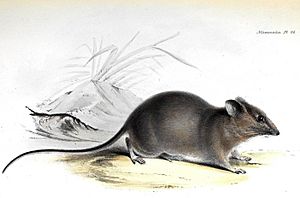Galápagos oryzomys facts for kids
Quick facts for kids Galápagos oryzomys |
|
|---|---|
 |
|
| The extinct subspecies A. galapagoensis galapagoensis | |
| Conservation status | |
| Scientific classification | |
| Genus: |
Aegialomys
|
| Species: |
galapagoensis
|
| Synonyms | |
|
Oryzomys bauri |
|
The Galápagos rice rat (Aegialomys galapagoensis) is a type of rodent that lives only on the Galápagos Islands. It is sometimes called the Galápagos oryzomys. These unique rats are an important part of the islands' wildlife.
Contents
What Does the Galápagos Rice Rat Look Like?
The Galápagos rice rat is a medium-sized rodent. Its body, from head to tail, is about 20 to 35 centimetres (7.9 to 13.8 in) long. Its tail adds another 14 to 17 centimetres (5.5 to 6.7 in) to its length.
It has very long, soft, and thick fur. The fur on its back is a mix of copper-brown colors. Its belly is a yellowish-grey color. The rat's ears are long and covered with thick hair. Its feet have large pads on the bottom, and its claws can be up to 2.5 millimetres (0.1 in) long. These features suggest that it doesn't climb much.
Where Do Galápagos Rice Rats Live?
The Galápagos rice rat is found only in the eastern part of the Galápagos Islands. Today, you can find them on Santa Fé Island. They might also live on Santiago Island.
In the past, a different group of these rats lived on San Cristóbal Island. This group is thought to be a separate subspecies. Sadly, it is believed to have become extinct many decades ago. The natural home for these rats is dry shrubland in warm, tropical areas.
How Do Galápagos Rice Rats Live?
The Galápagos rice rat is mostly active at night. However, you might sometimes see them moving around before the sun sets. During the day, they rest in cracks under lava rocks or beneath shrubs.
These rats eat both plants and insects, making them omnivores. Like many animals on the Galápagos Islands, they are very tame. They are not afraid of humans. Scientists who work on Santa Fé Island have shared stories about these rats. They sometimes have to keep their tents open to stop the rats from chewing their way inside at night! You can also often spot them on beaches. They are drawn there by fish remains left behind by people.
Reproduction and Life Cycle
Galápagos rice rats seem to have their babies mostly during the hot season. Young rats are usually born between March and May. However, they might have babies at other times of the year too. This could depend on how much food is available.
A mother rat usually gives birth to 2 to 7 babies at a time. The babies are born without fur and cannot see. Their eyes open and their adult fur grows in by about 13 days after birth. The longest a Galápagos rice rat has been known to live in the wild is 599 days.
History and Relatives
The Galápagos rice rat was once placed in a different group called Oryzomys. The subspecies A. g. bauri, which lives on Santa Fé Island, is sometimes thought to be its own full species.
The subspecies A. g. galapagoensis used to live on San Cristóbal Island. Charles Darwin himself collected some live specimens of this rat in 1835 during the second voyage of HMS Beagle. Sadly, it is believed that this subspecies became extinct just a few decades after Darwin's visit. Later, in 1984, scientists found fossil remains of these rats in lava tubes.
The closest living relative of the Galápagos rice rat is Aegialomys xanthaeolus. This is the only other species in the same group, and it lives in coastal areas of Ecuador and Peru.
See also
 In Spanish: Aegialomys galapagoensis para niños
In Spanish: Aegialomys galapagoensis para niños


